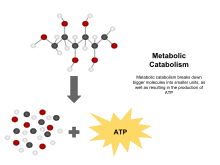Catabolism
This articleneeds additional citations forverification.(April 2023) |


Catabolism(/kəˈtæbəlɪzəm/) is the set ofmetabolicpathways that breaks downmoleculesinto smaller units that are either oxidized to releaseenergyor used in otheranabolicreactions.[1]Catabolism breaks down large molecules (such aspolysaccharides,lipids,nucleic acids,andproteins) into smaller units (such asmonosaccharides,fatty acids,nucleotides,andamino acids,respectively). Catabolism is the breaking-down aspect ofmetabolism,whereas anabolism is the building-up aspect.
Cells use the monomers released from breaking down polymers to either construct new polymer molecules or degrade the monomers further to simple waste products, releasing energy. Cellular wastes includelactic acid,acetic acid,carbon dioxide,ammonia,andurea.The formation of these wastes is usually anoxidationprocess involving a release of chemical free energy, some of which is lost asheat,but the rest of which is used to drive the synthesis ofadenosine triphosphate(ATP). This molecule acts as a way for the cell to transfer the energy released by catabolism to the energy-requiring reactions that make upanabolism.
Catabolism is a destructivemetabolismand anabolism is a constructive metabolism. Catabolism, therefore, provides the chemical energy necessary for the maintenance and growth of cells. Examples of catabolic processes includeglycolysis,thecitric acid cycle,the breakdown of muscle protein in order to use amino acids assubstratesforgluconeogenesis,the breakdown offatinadipose tissuetofatty acids,andoxidative deaminationof neurotransmitters bymonoamine oxidase.
Catabolic hormones[edit]
There are many signals that control catabolism. Most of the known signals arehormonesand the molecules involved in metabolism itself.Endocrinologistshave traditionally classified many of the hormones asanabolicor catabolic, depending on which part of metabolism they stimulate. The so-called classic catabolic hormones known since the early 20th century arecortisol,glucagon,andadrenaline(and othercatecholamines). In recent decades, many more hormones with at least some catabolic effects have been discovered, includingcytokines,orexin(known ashypocretin), andmelatonin.[citation needed]
| Hormone | Function[2] |
|---|---|
| Cortisol | Released from theadrenal glandin response to stress; its main role is to increase blood glucose levels bygluconeogenesis. |
| Glucagon | Released from alpha cells in the pancreas either when starving or when the body needs to generate additional energy; it stimulates the breakdown ofglycogenin the liver to increase blood glucose levels; its effect is the opposite of insulin; glucagon and insulin are a part of a negative-feedback system that stabilizes blood glucose levels. |
| Adrenaline | Released in response to the activation of the sympathetic nervous system; increases heart rate and heart contractility, constricts blood vessels, is a bronchodilator that opens (dilates) the bronchi of the lungs to increase air volume in the lungs, and stimulatesgluconeogenesis. |
Etymology[edit]
The wordcatabolismis fromNeo-Latin,which got the roots fromGreek:κάτωkato,"downward" and βάλλεινballein,"to throw".
See also[edit]
- Autophagy
- Dehydration synthesis
- Hydrolysis
- Nocturnal post absorptive catabolism
- Psilacetin § Pharmacology
- Sarcopenia
References[edit]
- ^de Bolster, M.W.G. (1997)."Glossary of Terms Used in Bioinorganic Chemistry: Catabolism".International Union of Pure and Applied Chemistry. Archived fromthe originalon 2017-01-21.Retrieved2007-10-30.
- ^
 This article incorporatestextavailable under theCC BY 4.0license.Betts, J Gordon; Desaix, Peter; Johnson, Eddie; Johnson, Jody E; Korol, Oksana; Kruse, Dean; Poe, Brandon; Wise, James; Womble, Mark D; Young, Kelly A (June 8, 2023).Anatomy & Physiology.Houston: OpenStax CNX. 24.1 Overview of metabolic reactions.ISBN978-1-947172-04-3.
This article incorporatestextavailable under theCC BY 4.0license.Betts, J Gordon; Desaix, Peter; Johnson, Eddie; Johnson, Jody E; Korol, Oksana; Kruse, Dean; Poe, Brandon; Wise, James; Womble, Mark D; Young, Kelly A (June 8, 2023).Anatomy & Physiology.Houston: OpenStax CNX. 24.1 Overview of metabolic reactions.ISBN978-1-947172-04-3.
External links[edit]
 Media related toCatabolismat Wikimedia Commons
Media related toCatabolismat Wikimedia Commons

